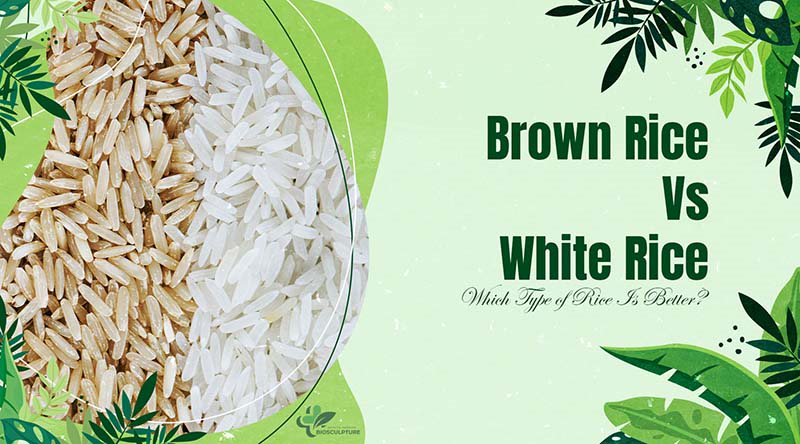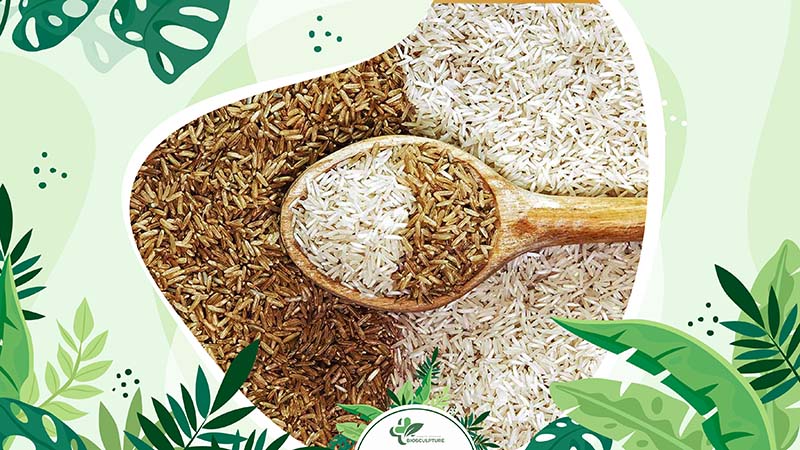Rice, a culinary mainstay for millennia, has traversed cultural boundaries, establishing itself as a dietary cornerstone in numerous nations worldwide, notably in various Asian countries such as China, India, Japan, and South Korea. In recent times, this humble grain has transcended its cultural origins, securing a permanent place in pantries across America and beyond.
Traditionally, white rice has held sway as the preferred choice. However, the rise in health consciousness has propelled brown rice into the spotlight, acclaimed for its purported nutritional superiority over its white counterpart. But what exactly sets brown rice apart from white rice in terms of nutritional content? How do these distinctions influence our health outcomes, if at all? And does making the switch from white rice to brown rice truly confer health benefits, whether when ordering takeout or planning meals at home?
In this article, we will explore the nutritional differences between brown rice vs white rice, unraveling the complexities of their respective health implications. It’s time to tackle the tough questions surrounding rice nutrition and make the best choices to optimize a healthy diet.

1. Differences Between Brown Rice and White Rice
When comparing brown rice vs white rice, we need to clearly understand their nutritional differences. Both types consist mainly of carbohydrates, with minimal protein and fat content.
Brown rice stands out as a whole grain, retaining all parts of the grain: the fibrous bran, the nutrient-rich germ, and the carb-rich endosperm. Its chewy texture and longer cooking time are attributed to the presence of the tough bran exterior.
In contrast, white rice undergoes processing that removes the bran and germ, leaving behind the carb-rich endosperm. Consequently, white rice lacks the essential nutrients found in the bran and germ. However, it boasts a softer texture and cooks more quickly than brown rice.
In summary, while brown rice offers superior nutritional value due to its retention of bran and germ, white rice is favored for its softer texture and shorter cooking time.

2. Brown Rice and White Rice: Nutritional Composition Comparison
To understand the difference between brown rice and white rice, it is necessary to examine their physical and nutritional properties. Clinical dietitian Caitlin Carr, MS, RD, elucidates this contrast by pointing out the refining process that alters the structure and nutrient composition of these grains.
White rice, post-refinement, comprises solely the starchy endosperm, devoid of the bran and germ that constitute the entire grain. Conversely, brown rice, known as a whole grain, retains all three components—the bran, germ, and endosperm.
In terms of nutritional content, brown rice takes the lead. Comparatively, it offers a notable advantage in fiber content. In a serving size of two-thirds of a cup, brown rice contains approximately two grams of fiber, while white rice trails behind with only about 0.5 grams.
Moreover, the disparity extends to vitamin and mineral content. Brown rice emerges as a richer source of essential minerals such as manganese, phosphorus, selenium, and magnesium. Additionally, it harbors B-vitamins like niacin and folate in higher quantities per cup than its refined counterpart.
Beyond vitamins and minerals, brown rice boasts a plethora of plant compounds, including flavonoids. These phytonutrients contribute to various aspects of health, spanning from gut and bone health to supporting heart, immune, and metabolic functions.
In essence, the nutritional profile of brown rice eclipses that of white rice, making it a superior choice for those seeking enhanced health benefits from their grain consumption.

3. Health Benefits Comparison Between Brown Rice and White Rice
Brown rice and white rice, though both dietary staples worldwide, diverge significantly in their health benefits due to processing variances. Here’s an insightful comparison of their health advantages:
3.1 Comparing the Benefits of Brown Rice and White Rice for Type 2 Diabetes
Brown rice, with its lower glycemic index (GI), is often favored over white rice for individuals managing type 2 diabetes. However, studies reveal that the glycemic impact of rice consumption might not dramatically alter blood sugar control indicators. Factors like longer cooking times for brown rice and dietary combinations influence its glycemic effect. Therefore, the choice between brown and white rice should consider personal health objectives and dietary balance, rather than solely relying on GI values.

3.2 Differences Between Brown Rice and White Rice for Cardiovascular Health
Opting for whole grains like brown rice over refined grains like white rice can significantly benefit cardiovascular health. The heightened nutrient content, particularly fiber and magnesium, contributes to reducing risk factors associated with heart disease, such as high cholesterol, elevated blood sugar levels, and hypertension.
3.3 Differences Between Brown Rice and White Rice for Weight Management
While evidence linking higher whole grain intake with reduced risks of weight gain is established, the specific impact of white rice versus brown rice on weight remains uncertain. Studies show conflicting associations with weight changes based on population cohorts and meta-analyses of randomized controlled trials. Regardless, maintaining a balanced diet and calorie control are pivotal in weight management, with both white and brown rice being viable components when consumed in moderation.

3.4 Antioxidant Capabilities Comparison Between Brown Rice and White Rice
Brown rice outshines white rice in antioxidant capabilities, making it a preferable choice for enhancing overall dietary health. Antioxidants play a crucial role in combating oxidative stress and inflammation, thus mitigating the risk of chronic diseases. By opting for brown rice, individuals can capitalize on its superior nutritional value, including heightened antioxidant properties.
3.5 Benefits of Brown Rice and White Rice for Overall Health
Brown rice, enriched with its bran and germ layers, offers a nutritional edge with its fiber, vitamins, minerals, and antioxidants. It aids in digestive health, weight management, and disease prevention, with a low glycemic index and high fiber content facilitating blood sugar control. Conversely, white rice, while lower in nutrients due to processing, provides quick energy, ease of digestion, and cooking versatility. Enriched varieties address specific nutrient deficiencies, catering to diverse dietary needs. Ultimately, both brown and white rice hold value in a balanced diet, with brown rice emerging as the superior choice for enhanced nutritional benefits.
4. Brown Rice Vs White Rice: Which Rice Is Better?
Determining whether white rice or brown rice is the superior choice depends on various factors, making it a nuanced decision. Both types can contribute positively to a well-rounded diet, but individual health needs and preferences play a crucial role in selecting the most suitable option.

For individuals with inflammatory bowel diseases (IBD) like Crohn’s disease or ulcerative colitis, or those recovering from bowel surgery, opting for foods lower in residue or fiber is advisable to promote comfortable digestion. In such cases, white rice emerges as the optimal choice due to its lower fiber content.
Conversely, for those without underlying digestive issues, brown rice offers a preferable option owing to its rich fiber and nutrient composition. Complex carbohydrates, as found in brown rice, generally represent a healthier choice.
One study found that brown rice may aid weight control in certain groups of people, suggesting potential benefits in preventing weight gain. Although more research is needed to elucidate the exact impact of whole grains on weight, evidence shows promising results. Additionally, replacing brown rice with white rice in the diet may help reduce the risk of developing type 2 diabetes, as research results have demonstrated.
Furthermore, studies indicate that incorporating brown rice into one’s diet may contribute to reducing Hemoglobin A1C levels, particularly in individuals with metabolic syndrome and a high body mass index (BMI).
In essence, the choice between white rice and brown rice hinges on individual health goals and dietary requirements. While white rice may be preferable for those with specific digestive concerns, brown rice offers superior nutritional benefits and potential advantages in weight management and disease prevention. Ultimately, incorporating both varieties judiciously into a balanced diet ensures optimal nutrition and overall well-being.
5. Conclusion
In conclusion, the debate between brown rice vs white rice boils down to individual health goals. While brown rice boasts superior nutrition, white rice offers its own conveniences. We’d love to hear your experiences and feedback on rice choices! Don’t forget to explore more insightful blogs on rice nutrition and beyond at Biosculpture.
>>See other comparison articles:
1. The Difference Between Vitamin K Vs Potassium
2. Olive Oil Vs Vegetable Oil: Which Is Better for Your Health?
3. Manganese vs Magnesium: A Comprehensive Comparison
4. Basmati Vs Jasmine Rice: Exploring Unique Flavors & Recipes


